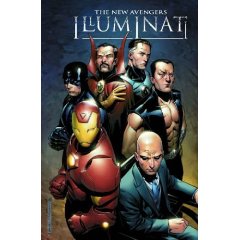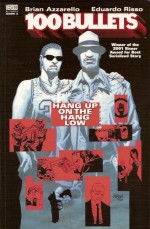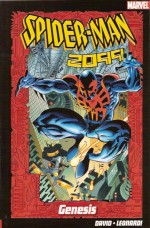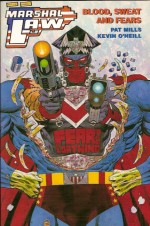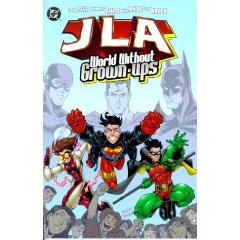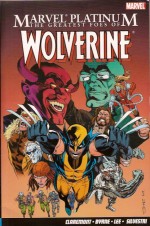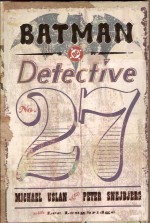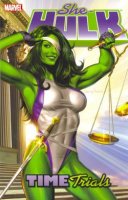
By John Broome, Gardner Fox, Gil Kane & various (DC Comics)
ISBN13: 978-1-4012-1264-3
As the Emerald Crusader entered his fourth year (which is how this second superb collection, reprinting issues #18 to 38 of the Silver Age series kicks off) the concept of the superhero was firmly reestablished among the buying public and there was no shortage of gaudily clad competition. The better books survived by having something a little “extra”. With Green Lantern that was primarily the superb scripts of John Broome and Gardner Fox and the astounding drawing of Gil Kane, whose dynamic anatomy and deft page design was maturing with every page he drew, but the concept itself was also a provider of boundless opportunity.
Other heroes had extraterrestrial, other-dimensional and even trans-temporal adventures, but the valiant champion of this series was also a cop: a lawman working for the biggest police force in the entire universe. As such his support team was necessarily composed of some the brightest talents in American comics. Green Lantern #18 (January 1963) led with ‘The World of Perilous Traps!’ by John Broome, regular penciller Gil Kane and inker Joe Giella who teamed to produce another cracking, fast paced thriller featuring the renegade GL Sinestro, whilst Mike Sekowsky penciled Kane’s layouts for the intriguing ‘Green Lantern Vs. Power Ring’ as Broome engineered a startling duel when hobo Bill Baggett took control of the Green Ring, necessitating a literal battle of wills for it power.
Green Lantern #19 saw the return of ultra-nationalist villain Sonar in ‘The Defeat of Green Lantern!’ (Broome, Kane & Giella) a high-energy cosmic duel nicely counter-pointed by the whimsical crime-caper ‘The Trail of the Horse-and-Buggy Bandits!’ by the same team, wherein a little old lady’s crossed phone line led the Emerald Gladiator into conflict with a passel of canny crooks. Issue #20 ‘Parasite Planet Peril!’ by Broome, Kane and Murphy Anderson reunited GL with the Flash in a full-length epic to foil a plot to kidnap human geniuses.
One of the DCU’s greatest menaces debuted in #21’s ‘The Man who Mastered Magnetism’. Broome created a world-beater in the duel-personality villain Doctor Polaris for Kane and Giella to draw, whilst ‘Hal Jordan Betrays Green Lantern!’ is the kind of action-packed, clever puzzle-yarn that Gardner Fox always excelled at, especially with Anderson’s stellar inks to lift the art to a delightful high.
Fox also scripted the return of diabolical futurist villain Hector Hammond in ‘Master of the Power Ring!’ (Giella inks) whilst Broome turned his hand to a human-interest story with the Anderson-inked ‘Dual Masquerade of the Jordan Brothers!’ as GL played matchmaker, trying to convince his future sister-in-law that her intended was in fact Green Lantern!
‘Threat of the Tattooed Man!’ kicked off #23, the first all-Fox scripted issue and the start of Giella’s tenure as sole inker, as the Ring-Slinger tackled a common thief who lucked into the eerie power to animate his skin-ink and ‘The Green Lantern Disasters’ took the hero off-world to rescue missing comrade Xax of Xaos, a insect member of the GL Corps. Issue #25 featured the first appearance of ‘The Shark that Hunted Human Prey!’ (Broome) wherein an atomic accident evolved the ocean’s deadliest predator into a psychic fear-feeder whilst ‘The Strange World Named Green Lantern!’ (Broome again) found the Emerald Crusader trapped on a sentient and lonely planet that craved his constant presence…
Green Lantern #25 featured Fox’s full-length thriller ‘War of the Weapon Wizards!‘ as GL fell foul of the lethally persistent Sonar and his silent partner-in-crime Hector Hammond, whilst Hal Jordan’s girlfriend Carol Ferris once more transformed into an alien queen determined to beat him into marital submission in ‘Star Sapphire unmasks Green Lantern!’– a witty cracker from Fox who also scripted the superb ‘World Within the Power Ring!’ as the hero battled an extraterrestrial sorcerer imprisoned within his ring by his deceased predecessor!
Fox’s super-scientific crime thriller ‘Mystery of the Deserted City!’ led in issue #27 whilst Broome charmed and alarmed with ‘The Amazing Transformation of Horace Tolliver!’, as Hal learned a lesson in who to help – and how. No prizes for guessing who – or what – menace returned in #28’s ‘The Shark Goes on the Prowl Again!’, but big applause if you can solve the puzzle of ‘The House that Fought Green Lantern’, both engaging romps courtesy of writer Fox whilst Broome added to his tally of memorable villain creations with the debut of Black Hand – the Cliché Criminal – who misappropriated a portion of GL’s power in ‘Half a Green Lantern is Better than None!’ as well as scripting a brilliant alien invader tale in ‘This World is Mine!’
This issue, #29, is doubly memorable as not only does it feature a rare – for the times – Justice League cameo (soon to be inevitable – if not interminable – as comics continuity became an unstoppable force in all companies’ output) but also because the incredibly talented Sid Greene became the regular inker.
Issue #30 featured two more Broome tales; the dinosaur attack thriller ‘The Tunnel through Time!’ and a compelling epic of duty and love as Katma Tui, who replaced the renegade Sinestro learned ‘Once a Green Lantern… Always a Green Lantern!’ The same writer also provided the baffling mystery ‘Power Rings for Sale!’ and the tense Jordan Brothers thriller ‘Pay Up – or Blow Up!’ whilst Fox handled all of #32, the tantalizing crime caper ‘Green Lantern’s Wedding Day!’ and the trans-galactic Battle Royale ‘Power Battery Peril!’
Nefarious villain Dr. Light decided to pick off his enemies one by after his defeat in Justice League of America #12 (see Showcase presents Justice League of America volume 1). His attempts in various member’s home titles reached GL with #33, but here too he got a damned good thrashing in ‘Wizard of the Light Wave Weapons!’, whereas the thugs in the back-up yarn, as well as giving artist Gil Kane another excuse to show his love of and facility with movie gangster caricatures, came far to close to ending the Emerald Gladiator’s life in ‘The Disarming of Green Lantern!’
Fox had by this time become lead writer and indeed wrote all the remaining stories in this volume. ‘Three-Way Attack against Green Lantern!’ in #34 was another full-length cosmic extravaganza as Hector Hammond discovered the secrets of the Guardians and launched an all-out assault on our hero, whilst both scripts in #35; costumed villain drama ‘Prisoner of the Golden Mask!’ and brain-swop spy-saga ‘The Eagle Crusader of Earth!’ looked much closer to home for their abundance of thrills, chills and spills.
GL #36 cover-featured the captivatingly bizarre ‘Secret of the Power-Ringed Robot!’ (how can you resist a tale that is tag-lined “I’ve been turned into a robot… and didn’t even know it!”?) and followed that all-action conundrum with the incredible tale of Dorine Clay; a young lady who was the last hope of her race against the machinations of the dread alien Headmen in ‘Green Lantern’s Explosive Week-End!’
Physical combat had been gradually overtaking ring magic in the pages of the series and #27’s ‘The Spies who “Owned” Green Lantern!’ despite being a twist-heavy drama of espionage and intrigue was no exception, whilst the second story ‘The Plot to Conquer the Universe!’ pitted the Emerald Crusader against Evil Star, a foe both immortal and invulnerable, which gave the hero plenty of reasons to lash out in spectacular, eye-popping manner.
Green Lantern teamed with fellow corpsman Tomar Re to battle ‘The Menace of the Atomic Changeling!’ in a brilliant science fiction escapade and the issue (#38 if you’re still counting) as well as this terrific volume concludes with ‘The Elixir of Immortality!’ as criminal mastermind Keith Kenyon absorbed a gold-based serum to become a veritable superman. He might have been immune to Ring Energy (which can’t affect anything yellow, as eny Fule kno) but eventually our hero’s flashing fists brought him low – a fact he never forgot on the many occasions he returned as the merciless master criminal Goldface…
The increasingly vast scope of these tales would become a cornerstone of the greater DC Universe and the incredibly animated, dynamic art of Gil Kane transformed how action comics were drawn. These stories changed comics storytelling forever and they’re still some of the most entertaining and mesmerising reads in all superhero fiction. What more do you need to know…?
© 1963, 1964, 1965, 2007 DC Comics. All Rights Reserved.


